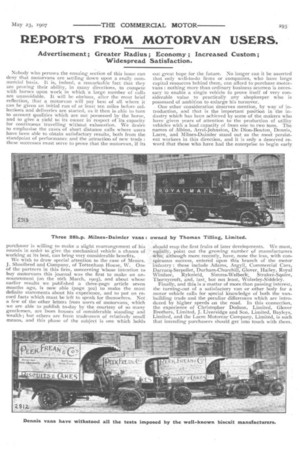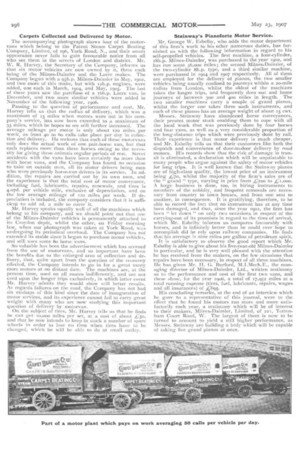REPORTS FROM MOTORVAN USERS.
Page 13

Page 14

If you've noticed an error in this article please click here to report it so we can fix it.
Advertisement ; Greater Radius ; Economy ; Increased Custom; Widespread Satisfaction.
Nobody who peruses the ensuing section of this issue can deny that motorvans are settling down upon a really commercial basis. It is, indeed, a remarkable fact that they are proving their ability, in many directions, to compete with horses upon work in which a large number of calls are unavoidable. It will be obvious, after the most brief reflection, that a motoryan will pay best of all where it can be given an initial run of at least ten miles before collections and deliveries are started, as it then is able to turn to account qualities which are not possessed by the horse, and to give a yield to its owner in respect of its capacity for continuous travelling without exhaustion. We desire to emphasise the cases of short distance calls where users have been able to obtain satisfactory results, both from the standpoint of performance and the attraction of new trade : these successes must serve to prove that the motorvan, if its purchaser is willing to make a slight rearrangement of his rounds in order to give the mechanical vehicle a chance of working at its best, can bring very considerable benefits.
We wish to draw special attention to the case of Messrs. J. Shoolbred and Company, of Tottenham House, W. One of the partners in this firm, concerning whose intention to buy motorvans this journal was the first to make an announcement (on the ibth March, 1905), and about whose earlier results we published a three-page article seven months ago, is now able (page 302) to make the most definite statements about his experience, and to put on record facts which must be left to speak for themselves. Not a few of the other letters from users of inotorvans, which we are able to publish to-day by the courtesy of so many gentlemen, are from houses of considerable standing and wealth; hut others are from tradesmen of relatively small means, and this phase of the subject is one which holds
out great hope for the future. No longer can it be asserted that only well-to-do firms or companies, who have large capital resources behind them, can afford to purchase motorvans : nothing more than ordinary business acumen is necessary to enable a single vehicle to prove itself of very considerable value to practically any shopkeeper who is possessed of ambition to enlarge his turnover.
. One other consideration deserves mention, by way of introduction, and that is the important position in the industry which has been achieved by some of the makers who have given years of attention to the production of utility vehicles with a load capacity of from one to two tons. The names of Albion, Arrol-Johnston, De Dion-Bouton, Dennis, Lacre, and Milnes-Daimler stand out as the most persistent workers in this direction, and it is only a deserved reward that those who have had the enterprise to begin early.
should reap the first fruits of later developments. We must, equally, point out the growing number of manufacturers -Who, although more recently, have, none the less, with conspicuous success, entered upon this branch of the motor industry : these include Adams, Argyll, Commercial Cars, Darracq-Serpollet, Durham-Churchill, Glover, Halley, Royal Windsor, Ryknield, Simms-Welbeck, Straker-Squire, Thornycroft, and, last, but not least, Wolseley-Siddeley.
Finally, and this is a matter of more than. passing interest, the turning-out of a satisfactory van or other body for a motor vehicle calls for special knowledge of both the vanbuilding trade and the peculiar differences which arc introduced by higher speeds on the road. In this connection, the experience of Christopher Dodson, Limited, Glover Brothers, Limited, J. Liversidge and Son, Limited, Bayleys, Limited, and the Lacre Motorcar Company, Limited, is such that intending purchasers should get into touch with them. Carpets Collected and Delivered by Motor.
The accompanying photograph shows four of the motorvans which belong to the Patent Steam Carpet Beating Company, Limited, of 196, York Road, N., and their smart appearance never fails to gain favourable notice from all who see them in the streets of London and district. Mr. W. R. Harvey, the Secretary of the Company, informs us that six motor vehicles are now owned by it, three each being of the Milnes-Daimier and the Lucre makes. The Company began with a 9ih.p. Milnes-Daimler in May, 1902, and two more of this make, but with 12h.p. engines, were added, one each in March, 1904, and May, J9o5. The last of these years saw the purchase of a 1611.p. Lacre van, in December,. and two more similar vehicles were added in November of the following year, 1906.
Passing to the question of performance and cost, Mr. Harveytells us that the radius of delivery, which was a maximum of 15 miles when motors were not in his company's service, has now been extended to a maximum of 35 miles, which he hopes to see still further increased. The average mileage per motor is only about 120 Mites per • week, as from 40 to do calls take place per day in colteclion and delivery. He reckons that each of these motorvans only does the actual work of one pair-horse van, but that each replaces more than three horses owing to the necessity for giving these animals regular periods of rest. Street accidents with the vans have been certainly no more than with horse vans, and the Company has found no occasion to take on outside men, all its motor drivers being men who were previously horse-van drivers in its service. In addition, the repairs are carried out by its own men, and the experience is that the total cost of motor conveyance, including fuel, lubricants, repairs, renewals, and tires is 4.o7d. per vehicle mile, exclusive of depreciation, and on the low average mileage of 120 miles per week. If depreciation is included, the company considers that it is sufficient to add 2d. a mile to cover it.
Mr. Harvey speaks equally well of all the machines which belong to his company, and we should point out that one of the Milnes-Dahnler vehicles is permanently attached to its Croydon depot, whilst the other, on Friday morning last, when our photograph was taken at York Road, was undergoing its periodical overhaul. The Company has not extended its stable since it began to purchase motor vehicles, and still uses some 8o horse vans.
• So valuable has been the advertisement which has accrued from the use of motorvans, and so important have been the benefits due to the enlarged area of collection and delivery, that, quite apart from the question of the economy effected, the Company intends to go in for a great many more motors at no distant date. The machines are, at the present time, used on all routes indifferently, and are not Used upon the longer trips exclusively, in which latter event Mr. Harvey admits they would show still better results. As regards. failures on the road, the Company has not had six mishaps of this kind since the date of inauguration of motor services, and its experience cannot fail to carry great weight with many who are now studying this important question of delivery by rnotorvan.
On the subject of tires, Mr. Harvey tells us that he finds he can get. moot) miles per set, at a cost of about 4".5o, and that he now intends to keep in stock a number of spare Wheels in order to 'lose no time when tires have to be changed, which he will be able to do at small outlay.
Steinway's Pianoforte Motor Service.
Mr. George W. Eshelby, who adds the motor department of this firm's work tO his other numerous duties, haS furnished us with the following information in regard to his self-propelled vehicles. The first machine, a four-cylinder, Milnes-Daimler, was purchased in the year 1902, and has run some 36,000 miles; the second 141ilnes-Daimler, of the two-cylinder 8h.p. type, and a third similar machine, were .purchased in 1904 and' 1907 respectively. All-of them are employed for the delivery of pianos, the two smaller vehicles being usually confined, to journeys. within a 20-mile radius from London, whilst. the . oldest of the machines takes the longer trips, and, frequently does out and home journeys of .between 300 and 400 miles in length. The two smaller machines carry a couple of grand pianos, whilst the larger one takes three such instruments, and each of these pianos has an average weight of about 15 cwt.
Messrs._ Steinway have abandoned horse conveyances, their present, motor stock enabling them to cope with all the local .work that was previously done by four horses and four vans, as well as a very bonsiderable• proportion of the long-distance trips which were previously done by rail. Their experience is that motor delivery is much cheaper, and Mr. Eshelby tells us that their customers like both the dispatch and convenience of door-to-door delivery by road motors. His records show that the risk of damage in transit is eliminated, a declaration which will be unpalatable to many people who argue against the sa.fety of motor vehicles for long trips. It is well known that the Steinway pianos are of high-class quality, the lowest price of an instrument being £70, whilst the majority of the firm's sales are of the " grand " type, varying in price from .4:200 to ,L*.t,000. A large business is done, too, in hiring instruments to members of the nobility, and frequent removals are necessary from country to town houses, and from one seat to another, in consequence. It is gratifying, therefore, to be able to record the fact that no instrument has at any time been damaged, and that, since the year 1902, the firm has been " let down " on only two occasions in respect of the carrying-out of its promises in regard to the time of arrival, which Mr. Eshelby informs us compares favourably with horses, and is infinitely better than he could ever hope to accomplish did he rely upon railway companies. He finds that his average is nine miles per gallon of petroleum spirit.
It is satisfactory to observe the good report which Mr. Eshelby is able to give about his five-year-old Milnes-Daimler in particular, and he is very well pleased with the attention he has received from the makers, on the few oCcasions that repairs have been necessary, in respect of all three machines. Fle has given Mr. H. G. Burford, M.I.Me.ch.E., the managing director of Milnes-Daimler, Ltd., written testimony as to the performance and cost of the first two vans, and these show, for the year 1906, a total of 17,952 miles at a total running expense (tires, fuel, lubricants, repairs; wages and all insurances) of .,-;695.
Hi.s concluding remarks, at the end of an interview which he gave to a representative of this journal, were to the effect that he found his motors ran more and more satisfactorily each year, a testimony which will be of interest to their makers, Milnes-Daimler, Limited, of 221, Tottenham Court Road, W. The largest of them is now 10 be turned to account to yield a still higher performance, as Messrs. Steinway are building a body which will be capable of taking five grand pianos at once.






























